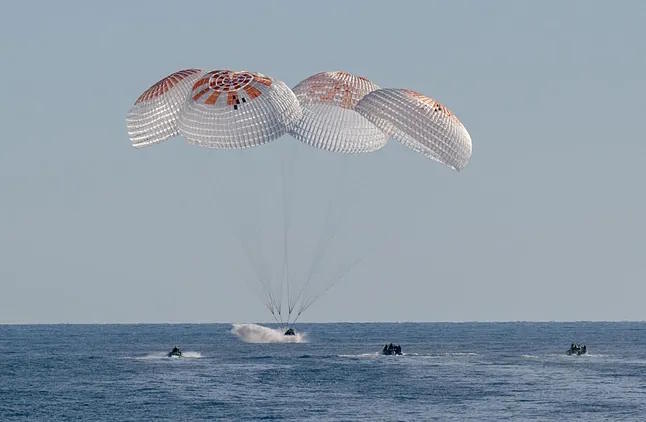Seventeen hours of space travel have ended tonight the eventful mission of Sunita Williams and Butch Wilmore. These two NASA veterans, popularly known as the 'stranded' or 'trapped' astronauts at the International Space Station (ISS), have finally returned to Earth at midnight after spending nine months in zero gravity. Two hundred and eighty-six days to be exact, during which they orbited the Earth over 4,500 times and, despite everything, became two of the most famous astronauts in the world by experiencing one of the biggest space crises.
A SpaceX spacecraft, Elon Musk's aerospace company, came to their rescue after being left without transportation back to Earth due to technical issues with Boeing's Starliner in which they had traveled in June to the ISS for their first manned flight. A mission that was supposed to last just over a week in total.
Prophetically, the Crew Dragon that brought them back home nine months later is named Freedom. It arrived at the ISS at the end of September with only two crew members - the American Nick Hague and the Russian Aleksandr Gorbunov - as two seats were reserved for Sunita Williams and Butch Wilmore. The spacecraft also carried two suits for the 'stranded' astronauts, as the ones they wore during the outbound journey are incompatible with SpaceX's suits.
Early on Tuesday, at 6:05 a.m., the Freedom spacecraft undocked from the ISS with its four crew members and began its journey back to Earth. For safety reasons, and as is customary during spacecraft splashdowns, maritime traffic was restricted in the entire Gulf of Mexico area where the capsule could land.
As planned, the spacecraft splashed down punctually at 10:57 p.m., two minutes after deploying the parachutes that allow for a slower descent. Moments later, several rescue boats and vessels surrounded the capsule to begin the rescue operations. They were also greeted by several dolphins, who approached, curious, to inspect the spacecraft, as seen during NASA's broadcast.
NASA and SpaceX personnel transferred the capsule to a maritime platform on a vessel, and minutes later, they opened the hatch revealing the four crew members seated in their seats, visibly happy and excited but tired from a mission of many months in space and a long 17-hour journey in the spacecraft.
One by one, they were released from their seats. They had to be helped to walk upon exiting, as the lack of gravity during such a long period had weakened their muscles and bones, especially noticeable in Sunita Williams.
As per standard procedure, all four were taken to land for an initial medical check-up to certify their health status, while their families eagerly awaited to reunite with them.
Sunita Williams and Butch Wilmore had to face an unexpected and very long extension of their mission that kept them in space for a much longer period than they could have imagined. Their adventure began on June 5 and was supposed to last just over a week, but technical issues detected in the Starliner spacecraft during their assigned first manned test flight led NASA to decide that the capsule would return empty to avoid risks for their astronauts. Williams and Wilmore would return on a SpaceX spacecraft, but they would have to stay at the ISS for a few months, until February. However, just when all media attention was on them, another setback with the Crew spacecraft led to a new postponement until the end of March.
In recent weeks, the crisis escalated when Donald Trump and Elon Musk accused the Biden Administration of abandoning the two NASA astronauts. Trump even publicly asked Musk to rescue them, despite the fact that it was in August when the space agency outlined the current plan and already established that a SpaceX spacecraft would bring back their astronauts.
A change in spacecraft allowed for an earlier return by about two weeks, although on Tuesday, NASA's acting director, Janet Petro,, emphasized the new administration's version and stated in a press release that "at the direction of President Trump, NASA and SpaceX worked diligently to advance the return by a month."
Last Sunday, the Crew-10 mission finally arrived at the ISS to enable the crew change. It consists of Americans Anne McClain and Nichole Ayers, Japanese Takuya Onishi, and Russian Kirill Peskov. The four were welcomed with enthusiastic hugs and uncontrollable joy. The return of Wilmore and Williams depended only on the weather. Although NASA had set Wednesday as the return day, the good weather forecast for Tuesday led the mission leaders to advance their long-awaited return by a day.
For both Sunita Williams (59 years old) and Butch Wilmore (62), this is their third space mission. NASA assigned these two veterans, who were also US Navy captains, the complex mission of testing the new Starliner spacecraft.
Despite the controversies, the extension was maximized for scientific purposes, as long stays are very valuable for space agencies. According to NASA, Williams and Wilmore were able to dedicate over 900 hours to research, during which they carried out about 150 experiments, once again demonstrating that astronauts are trained to handle any unforeseen circumstances.
